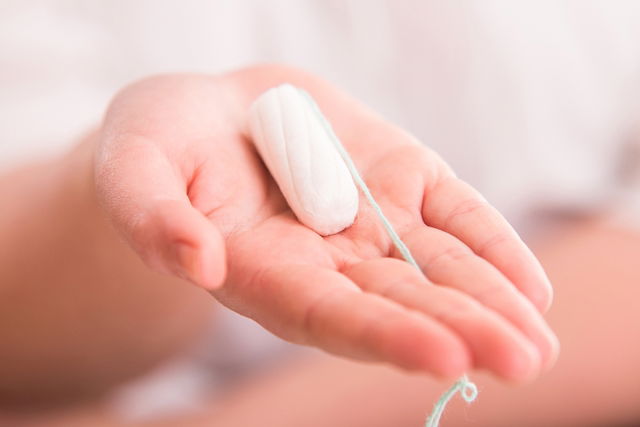A tampon is a type of absorbent pad that is inserted directly into the vagina to absorb period blood during menstruation. It is a great option for women who wish to go to the beach, swim or exercise during a period.
To insert a tampon safely and to prevent developing vaginal infections, it is essential to have clean hands whenever you insert or remove it. You should also consider changing it about every 4 hours, even if your menstrual flow is reduced.
Furthermore, to avoid getting a vaginal infection and developing symptoms such as itching, burning and green discharge, it is important to choose a tampon size that is adequate to the amount of period blood. A higher flow requires a larger tampon, for example. Another way to avoid infections is to avoid using a tampon every day because the heat and humidity inside the vagina increase this risk.

How to insert
To insert a tampon correctly without discomfort, you should:
- Prepare the tampon - if using an applicator, ensure it is in the inserting position. If using without an applicator, unwind the absorbent string and stretch it.
- Separate the vaginal lips with your free hand;
- Gently push the end of the applicator to insert tampon into the vagina, or using a finger at the base of a free tampon to insert. Be sure to aim the tip of the tampon towards your back and not straight up, as the vagina is tilted to your spine.
To make it easier to insert the tampon, the woman can stand and squat, stand with one leg supported on a bench or toilet, or sit with your legs open and knees wide apart.
Important precautions
It is important to consider the following measures to prevent infections and discomfort:
- Wash your hands before putting inserting or removing a tampon
- You can use a panty liner if you have small leaks
The tampon can be used by all healthy girls and women.
Also recommended: Period Tracker: Determine When Your Period is Due tuasaude.com/en/period-trackerRisks of using tampons
When used correctly, tampons are a safe and hygienic way of managing your period. Tampons do not damage your skin, and allows you to wear most clothes without and odors or soiling.
However, to use a tampon safely, it is essential to change it every 4 hours, even if your flow is low. You should never use a tampon for more than 8 hours at a time, especially in hot environments to avoid infections. You are also not advised to sleep with a tampon in.
The use of tampons is contraindicated during active vaginal infection, as it can worsen the condition. They should also not be used in the first 60 days of post-partum, as post-partum bleeding requires continuous monitoring.
When to see a doctor
When using tampons, special attention should be paid to symptoms such as:
- High fever that appears suddenly
- Body pain and headache without having a flu
- Diarrhea and vomiting
- Skin changes similar to a sunburn over the entire body
These may be a sign of toxic shock syndrome, which is a life-threatening infection that is commonly caused by inappropriate tampon that leads to the proliferation of bacteria in the vagina. This bacteria then spreads to the blood, and can potentially affect the kidneys and the liver.
If you experience any of these symptoms, remove the tampon immediately and proceed to the emergency room for assessment and treatment. Treatment usually involves IV antibiotics for at least 10 days in a hospital setting.






























